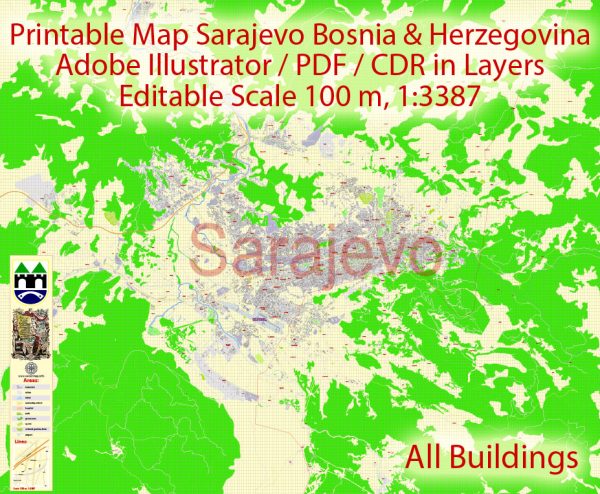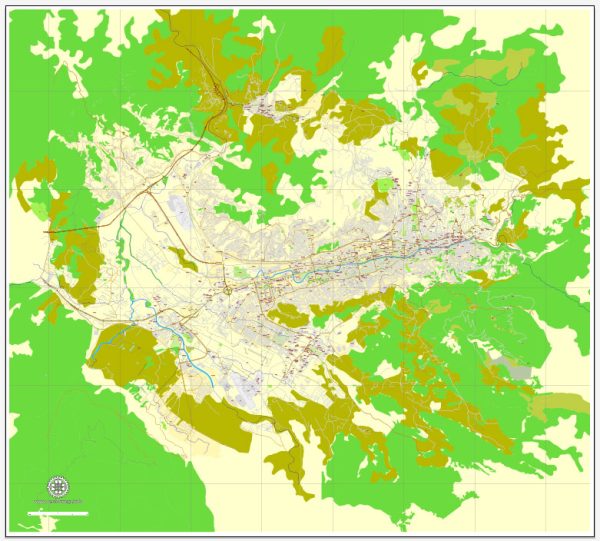Sarajevo, the capital of Bosnia and Herzegovina, is a city with a rich history and a blend of various cultural influences. Its historic places, buildings, streets, and squares reflect the city’s diverse past.
Vectormap.Net provide you with the most accurate and up-to-date vector maps in Adobe Illustrator, PDF and other formats, designed for editing and printing. Please read the vector map descriptions carefully.
Here’s a detailed description of some notable landmarks:
- Baščaršija: Baščaršija is the old bazaar and the historical and cultural center of Sarajevo. It was built in the 15th century and features narrow streets filled with various shops, traditional Bosnian cafes (čevabdžinica), and craftsmen’s workshops. The Sebilj fountain, located in the center of Baščaršija, is a popular meeting point.
- Gazi Husrev-beg Mosque: Constructed in the 16th century, this mosque is one of the finest examples of Ottoman architecture in Bosnia. It is part of the larger Gazi Husrev-beg Complex, which also includes a madrasa, a clock tower, and a covered market.
- Latin Bridge: This bridge gained historical significance as the site where Archduke Franz Ferdinand of Austria was assassinated in 1914, triggering the events that led to World War I. The Latin Bridge spans the Miljacka River and is a popular spot for both history enthusiasts and tourists.
- Sarajevo City Hall (Vijećnica): A stunning example of Austro-Hungarian architecture, Vijećnica was completed in 1896. It serves as the National and University Library and is known for its intricate Moorish Revival style. The building suffered severe damage during the Bosnian War but has since been reconstructed.
- Sarajevo Tunnel (Tunnel of Hope): Built during the Siege of Sarajevo (1992-1995), this underground tunnel was used to supply the city with food, weapons, and humanitarian aid. A section of the tunnel is open to the public, offering insight into the challenges faced during the war.
- Bijela Tabija: Also known as the White Fortress, Bijela Tabija is a medieval fortress that provides panoramic views of Sarajevo. While the fortress itself is mostly in ruins, its location on a hill offers an excellent vantage point for observing the city.
- Sarajevo Cathedral (Cathedral of Jesus’ Heart): This Catholic cathedral was consecrated in 1889 and is an example of neo-Gothic architecture. It stands as a symbol of Sarajevo’s religious diversity.
- Eternal Flame: Located in the center of Sarajevo, the Eternal Flame is a memorial honoring the military and civilian victims of World War II. The flame has been continuously burning since its inauguration in 1946.
- Ferhadija Street: One of the oldest streets in Sarajevo, Ferhadija is a pedestrian zone lined with shops, cafes, and historical buildings. It connects Baščaršija to the modern part of the city.
- Sarajevo National Theatre: Built in 1899, this theater is an architectural gem and a cultural hub. It hosts various performances, including drama, opera, and ballet.
These landmarks collectively tell the story of Sarajevo, a city that has endured diverse influences and challenges throughout its long and storied history.



 Author: Kirill Shrayber, Ph.D.
Author: Kirill Shrayber, Ph.D.